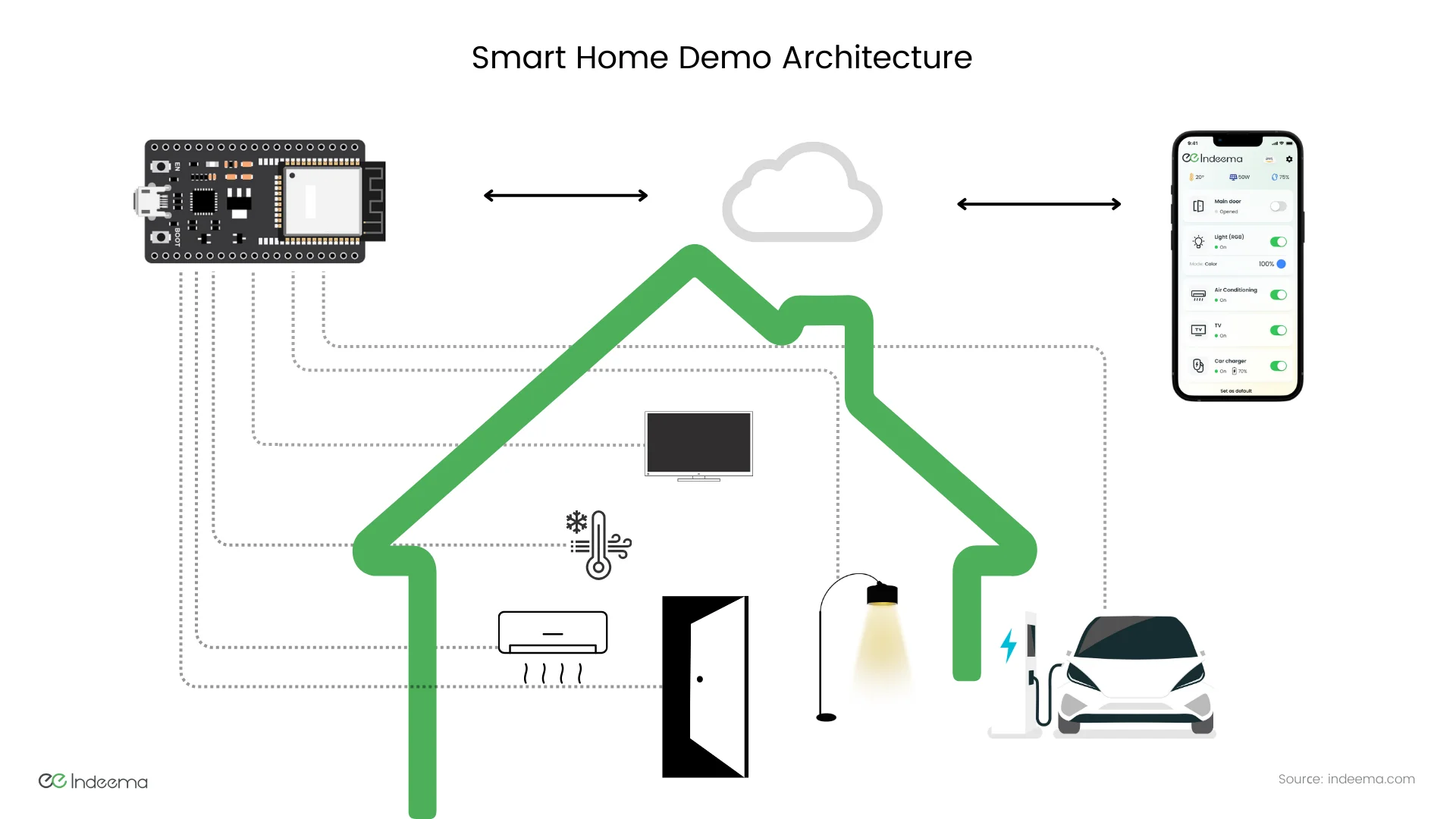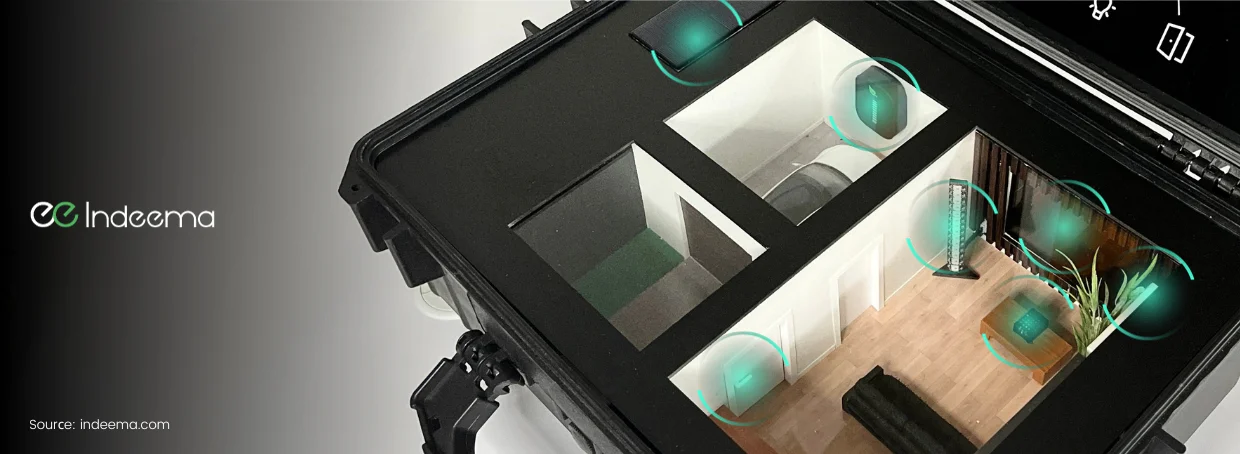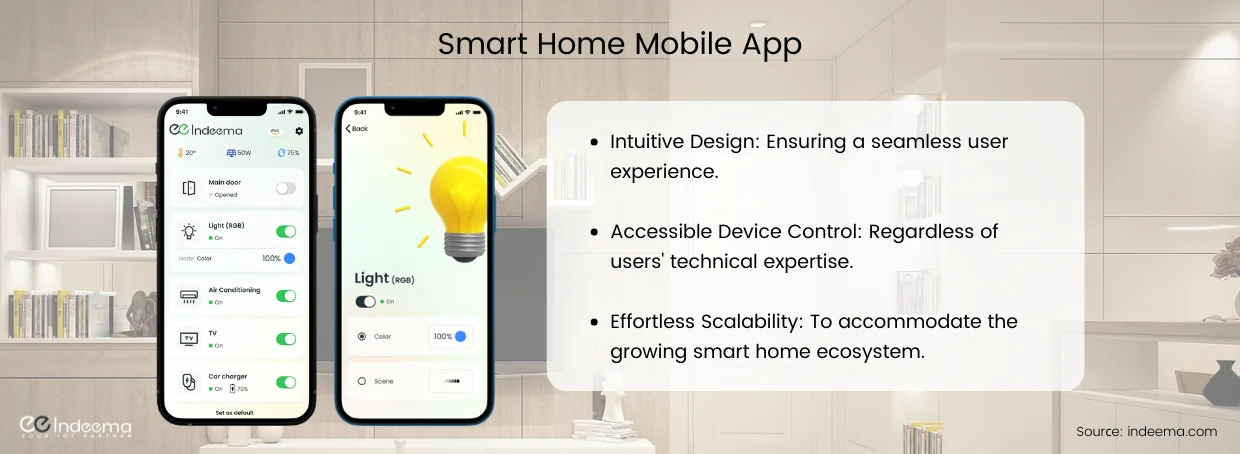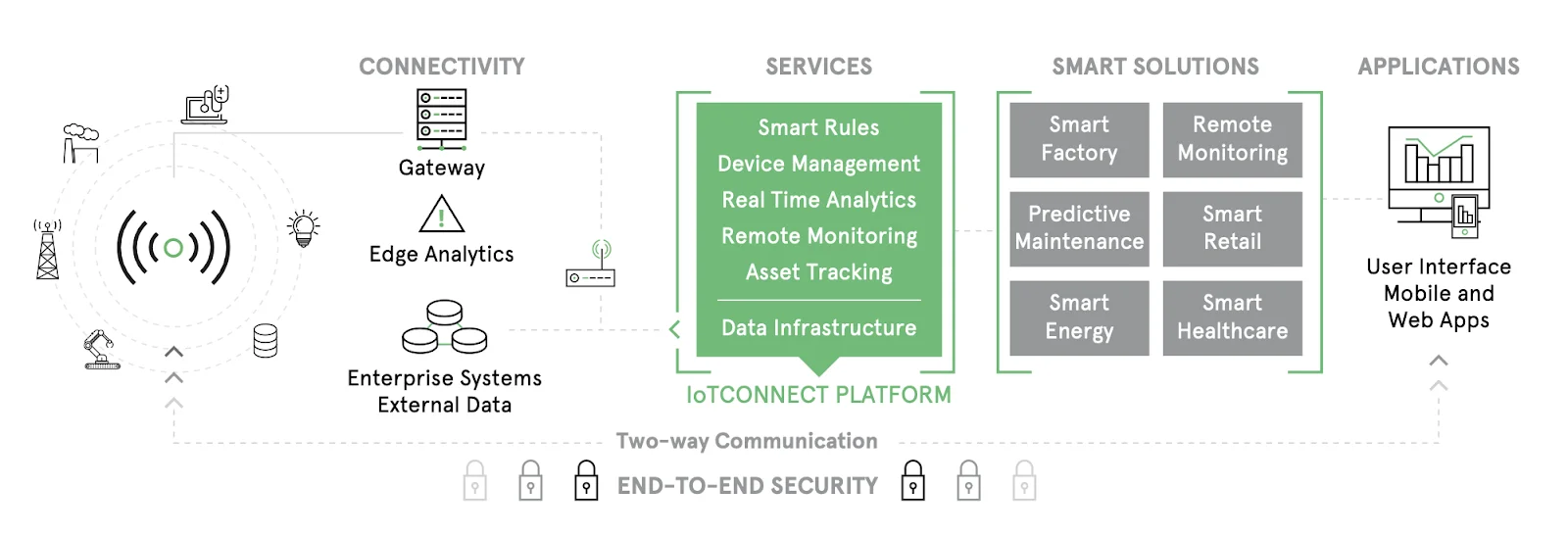Introduction
In our ongoing exploration of smart home technology, we have previously examined the intricacies of its hardware components, software development, and mobile apps and even pondered the future of these connected spaces. Building upon this foundation, our latest article delves into an exciting new dimension: a miniature rendition of a smart home.
In this smart home IoT case study, we will unravel the inner workings of a smart home system, identify its core components, and shed light on the collaborative effort required to bring such a project to life.

The smart home industry is constantly evolving, offering both exciting opportunities and challenges. As more and more houses adopt the idea of connected living, the demand for strong, secure, and user-friendly solutions becomes more and more crucial. By exploring the example of smart home technology, we can catch a glimpse of this dynamic field and the innovations that are shaping our way of life.
1. Creating Compact Smart Home Demo
In the constantly changing world of smart home technology, it is crucial to have a clear understanding of how everything works and fits together. Step into Indeema's Smart Home IoT Demo, a small yet impressive creation that perfectly captures the essence of a connected home. It provides us with the opportunity to explore its inner workings with unparalleled convenience.

1.1 The Elements of the Smart Home System Demo
The Smart Home IoT Demo consists of three essential components, each with its unique role in making this compact connected home functional.
1. A House Model in a Suitcase: Imagine it as a miniature version of modern living that can be packed into a suitcase. Not only does this compact house model visually represent what a smart home could look like, but it also serves as a practical showcase for on-the-go demonstrations.
2. IoT Platform: The robust IoT platform is at the core of our smart home demo. This is the place where the magic happens, where data from different sensors and devices comes together, and where commands are carried out to provide a smooth smart home experience.
3. Mobile App: A mobile app is the user's gateway to this smart world. This app is built on the iOS platform and serves as a control centre, enabling users to interact with the smart home and experience its functionalities directly.

1.2 Interfaces for User Interaction
When it comes to user interaction, the interfaces we design have a crucial role in shaping the user experience. The smart home demo includes the following interfaces:
- Mobile App: The mobile app allows users to have control over different aspects of their smart home. They have everything at their fingertips, from adjusting climate settings to managing access control and even controlling lights and the TV.
- Web Portal: To provide a more comprehensive view and enable remote control, we created a web portal. This interface allows users to access and control the smart home through a browser, making it even more versatile.
1.3 Hands-On Demonstration of Key Smart Home Features
The process of creating a smart home is defined by important decisions. In our case, the objective was to showcase the most essential smart home features. We have chosen features that accurately represent real-life scenarios, reflecting the everyday routines and requirements of homeowners.
 The key elements we have chosen to showcase are:
The key elements we have chosen to showcase are:
- Solar Energy Harvesting: Our smart home demonstrates the incredible potential of sustainable energy sources, specifically highlighting the efficient harnessing of solar energy in a modern household.
- Smart Charging: In this era of electric vehicles and increasing concerns about sustainability, this demo showcases the convenience and eco-friendliness of smart charging solutions.
- Climate control: The comfort and energy efficiency of precise climate control demonstrate how smart homes adapt to users' preferences.
- TV and Lights Control: By simply tapping on the mobile app, users can control their entertainment and lighting, allowing them to customize their living space according to their mood.
- Access Control: Smart Home demo brings security to the forefront. It shows how Smart Lock solutions can enhance home security and convenience.
This project highlights the main IoT features that are typically found in smart home systems. However, the comfort and energy efficiency that IoT technology has brought about are truly impressive, and modern smart home projects are becoming more and more complex.
From advanced climate control systems that adjust temperature and humidity according to users' preferences and schedules, to intelligent lighting solutions that adapt to users' moods and activities.
2. How We Build Smart Home Using IoT
Now let's jump right into the meat of it and see how the Indeema team built a smart home demo. The goal was to demonstrate how to build a smart home mini-model in order to offer helpful insights into the development process.
In our IoT Smart Home example, we have condensed all the functionalities of a full-fledged smart home, including a living area and a garage.

2.1 Developing Overall Architecture
At the core of the IoT Suitcase project lies a robust architecture, connecting all the components of our smart home.
What makes this demonstration stand out is not only its small size, but also the distinctive architectural design that allows users to observe the intricate flow of signals, starting from the sensors to the central MCU (Microcontroller Unit), cloud, and finally, to the mobile application.
The sensors and devices we have selected for the smart home demonstration use various interfaces and protocols. This enables users to control and monitor devices like the main door, air conditioner, humidity sensor, lighting, EV car charger, and TV. All of this can be done through a dedicated mobile application.

A Compact Smart Home Ecosystem
The smart home model inside the suitcase has been carefully designed to replicate a real home. It includes a single room and a garage, which contain a variety of smart devices that embody the core of modern home automation.

Signal Flow Visualization
One of the most impressive aspects of this smart home demonstration is how the components are positioned. The smart home is located in the lower part of the suitcase, and the data flow visualization panel is integrated into the cover section. When a user commands a smart home device through the mobile app, the cloud-to-MCU and MCU-to-device message paths are visually indicated with running lights that show the direction of data flow.

Web Dashboard
A web dashboard is another way to access real-time and recent historical data from smart home devices. It enables the analysis of trends over time and aids in identifying usage patterns.
This hands-on experience offers a one-of-a-kind opportunity to grasp the intricate workings of a smart home system.
2.2 Selecting and Integrating Smart Devices
Building a smart home naturally requires careful consideration of every sensor and device. Let's explore the hardware and control methods that enable this smart home demo.
Hardware Components:
1. Servo Motor: A key component that enables the movement of objects like the main door, providing remote access control.
2. DC Motor: Used for applications such as controlling blinds or curtains, offering a seamless integration into the smart home system.
3. A humidity sensor, capable of monitoring both temperature and humidity, provides essential information for ensuring comfort within the smart home.
4. LED Strip: allows to create dynamic lighting and ambiance, enhancing the smart home experience.
5. Multicolor Battery Capacity Indicator Module: a vital component for monitoring and managing the power supply of various devices within the smart home, such as charging stations.
6. A display interface providing a user-friendly summary of the state of the entire smart house.
Interface and Control Methods:
1. PWM (Pulse Width Modulation): used to control different devices such as servo and DC motors, enabling precise and adjustable control over their movements.
2. GPIO (General Purpose Input/Output) (ON/OFF): used for toggling devices on and off, providing users with direct control over the connected appliances.
3. Digital One-Wire Communication: used to transmit data, allowing for smooth information flow between devices and the central control system.
4. One-Wire NZR: utilized to facilitate dependable and effective data exchange among the various components of a smart home, thereby enhancing the system's responsiveness.
5. GPIO (Control) and Analog (Readout): Combining GPIO for control and analog signals for data reading offers a balanced and comprehensive solution for device management and feedback.
6. UART (Universal Asynchronous Receiver-Transmitter): is used for bidirectional data exchange, allowing real-time monitoring and control of devices in the smart home.
Selecting and integrating smart devices into a smart home is a crucial step in creating a connected living space that fulfills customers' requirements. By focusing on use cases, compatibility, security, and scalability, developers have the ability to create innovative solutions that enhance the smart home experience while ensuring a high level of user satisfaction and data security.
2.3 Firmware Development: Making Devices Communicate Seamlessly
During this development stage, the team of embedded engineers has a clear objective: to ensure that smart home devices can communicate seamlessly, regardless of their diverse origins and functionalities.
Modular and Scalable Design
The smart home ecosystem consists of a variety of devices, each with its own distinct role and specifications. In order to accommodate this diversity, our firmware has been meticulously designed to be modular and scalable. This means that when new devices or features are introduced, they can be seamlessly integrated into the current setup. Whether it's a new sensor for monitoring another aspect of the environment or a new smart device that enhances home automation, the firmware is prepared to adapt, expand, and effortlessly integrate these new components.
It also prioritizes low power consumption, which means that smart devices can operate for long periods without significantly affecting energy bills.
Over-the-Air (OTA) Updates
OTA updates are an essential part of modern smart home systems. They allow for remote and wireless firmware updates for different interconnected devices. These updates are crucial for ensuring the health, functionality, and security of smart home ecosystems. There is no need for users to manually update each device, as the smart home system centrally manages the process.
Interoperability with IoT Platforms
The Internet of Things (IoT) relies heavily on interoperability between devices. Our firmware is designed to work seamlessly with a variety of IoT platforms. In our case, we used IoTConnect on AWS. It enables a unified and synchronized experience, ensuring that data flows smoothly and securely between smart home devices and the selected cloud services.
In summary, our firmware development is the backbone of the smart home's communication and functionality. It's designed to adapt, conserve power, receive updates effortlessly, and seamlessly collaborate with the broader IoT landscape.
2.4 Software Development: The Heart of the Demo
The brains of our smart home demo is our IoT Suitcase app. Its intuitive design illustrates how easy it is to set up and manage Internet of Things gadgets. Users can monitor environmental conditions, manage their devices, and tailor their Internet of Things experience to their specific requirements.

In the image above, we can observe two primary screens of the application:
- Home Screen: The home screen provides a complete list of connected devices, making it easy for users to manage and monitor them.
- Light Settings Menu: In this section, users have the option to customize the lighting to suit their personal preferences.
Additional screens also enable users to establish Wi-Fi connections and effortlessly switch between cloud platforms.
The mobile app enables users to remotely control devices by either clicking within the app or using voice commands. iOS devices offer a feature known as "Shortcuts" that allows users to create custom voice commands and automations. This feature has important implications for controlling smart homes.
Using Shortcuts, users have the ability to create personalized voice commands for carrying out specific actions in their smart home. For example, in our home, we have programmed a command called "Movie Time" that dims the lights and turns on the TV. By simplifying complex sequences of actions into a single command, these voice-activated shortcuts elevate smart home automation to a whole new level. This is a crucial feature in the industry of modern smart homes. It should come as no surprise that the market for voice assistants is expected to reach a staggering $99 billion by 2026.
In order to ensure the reliability and security of smart home environments, it is crucial to have an understanding of some of the most common examples of faults in software architecture for a smart home.
These faults can encompass a broad spectrum of issues, including security vulnerabilities, interoperability challenges, resource inefficiencies, and a lack of robust mechanisms for handling failures.
For instance, faulty software architecture may result in resource inefficiencies, such as devices running continuously when not required, excessive power consumption, or suboptimal utilization of computing resources. One possible solution could involve implementing intelligent power management and resource allocation algorithms.
2.5 IoTConnect Platform for Smart Home IoT Solutions
In a previous article, we discussed Platform as a Service (PaaS). Now, we turn our attention to the practical implementation of this concept in our smart home demonstration. To effectively manage devices and collect data, we've employed Avnet's IoTConnect Platform.

The IoTConnect Platform simplifies the development journey, providing companies with a ready-made foundation to quickly bring innovative smart home solutions to market without having to create systems from the beginning.
This platform serves as the connective tissue for all smart devices in a home, making device communication and data collection more efficient while maintaining strict security protocols.
With IoTConnect, companies can configure an unlimited number of on-premises and remote devices, enable cross-device communication, access real-time device information for analysis, set up automated notifications, and implement multi-layer security measures. It seamlessly interfaces with various tools essential for effective IoT deployment, fosters connectivity between devices, and integrates with existing CRM and ERP systems, thereby enabling smarter and more efficient homes for customers.
Indeema Software is proud to be an official member of the Avnet IoT Partner Program, which reflects our dedication to excellence in the Internet of Things (IoT) industry. By collaborating with Avnet, an industry leader, we have come together to offer high-quality IoT development services tailored to the specific requirements of mid-size companies and enterprises. This partnership brings together Avnet's extensive expertise and resources in the IoT field with our advanced technological solutions and development capabilities. The outcome is a strong collaboration that enables businesses to fully utilize the potential of IoT technology, making it easier to develop strong and customized solutions that meet their specific needs.
3. Data Privacy Illustrated: An Example of Smart Home Technology
The security of the information collected and transmitted within the smart home ecosystem is critical, and IoT platforms play a critical role in addressing these concerns. In our demo, we entrusted the task of data privacy and security to Avnet's robust IoTConnect Platform.
Certified Security with IoTConnect Platform:
To find and fix vulnerabilities, every ecosystem layer is scanned and monitored. This industrial-grade data security strategy includes several essentials:
- Our smart home devices have identity and authentication mechanisms to prevent unauthorized access.
- All data in transit and at rest is encrypted to protect it from interceptions.
- Authenticating servers with unique IDs prevents impersonation and unauthorized access.
- Certificate-Based Authentication: Certificates authenticate users and devices, adding security.
- Secured Network: The entire network is protected from unauthorized access.
- Logging: Detailed logging records all system actions for analysis.
- Incident Response Services: Our system responds quickly and effectively to security incidents.
- Continuous Monitoring: Our system detects and responds to security threats in real-time.
- Secure Communication Channels: Device-IoT platform communication channels are secured to prevent eavesdropping and tampering.
- Firmware updates are delivered securely to keep smart home devices' software up-to-date and secure.
Meeting Industry Standards with Avnet-Managed Cloud:
The cloud platform, a key part of data infrastructure, is certified against four ISO standards:
- Information Security Management Systems (ISMS)
- ISO 27017: Cloud security controls
- ISO 27018: Public cloud PII protection
- Quality management systems: ISO 9001
Data privacy and security are of the utmost importance in this day and age of connected smart homes. The comprehensive IoTConnect Platform, built to meet the most stringent security requirements, is the backbone of our smart home's data protection.
4. Partner with Indeema for Smart Home Excellence
As we've explored the specifics of smart home technology, it's become apparent that the path towards developing a fully integrated, high-tech home is rife with obstacles and possibilities. The innovation process often benefits from consulting with those who have built countless Internet of Things (IoT) systems for end customers. That's where Indeema steps in.
This case study delves into the smart home IoT ecosystem that Indeema has developed, serving as both a showcase and a testament to industry potential. We are fully dedicated to ensuring quality, security, and originality in every project we take on.
Collaborating with leaders such as IoTConnect enables us to offer solutions that truly stand out.
Every smart home is different, and we understand that there is no one-size-fits-all solution. We collaborate closely with our partners to create tailored solutions that meet specific requirements.
Conclusion
In summary, the process of creating a compact and engaging smart home demo is intricate. Balancing technology integration and optimizing the user experience are crucial factors.
Creating a smart home using IoT technology involves following a systematic approach. It includes the process of planning the architecture, meticulously selecting and integrating smart devices, developing the required firmware and software, and utilizing platforms such as IoTConnect for smooth IoT solutions.
Thanks to our extensive expertise, we are able to provide a practical and user-friendly demonstration of the capabilities of IoT and smart home technologies. As we continue to enhance and expand our smart home demo, our aim is to inspire and educate, making sure that IoT technology can revolutionize the way we engage with our living spaces.


